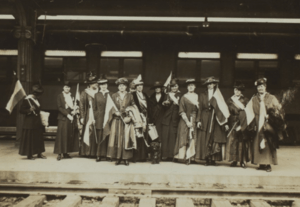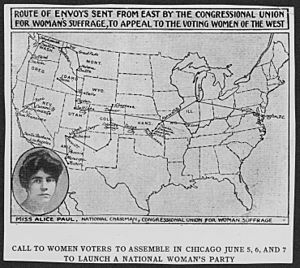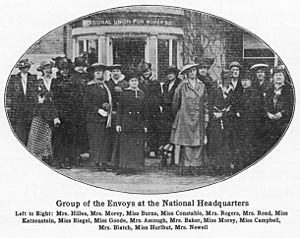Suffrage Special facts for kids
The Suffrage Special was a special train trip organized in 1916. It was created by a group called the Congressional Union for Woman Suffrage. This train traveled through states where women could already vote. These were called "free states." The women on the train wanted to spread the word about a national law. This law would give all women across the country the right to vote. They also hoped to start a new group, the National Woman's Party (NWP).
The Suffrage Special was also known as the "flying squadron." It left Washington, D.C., on April 9, 1916. For 38 days, it toured states in the Western United States by train. Many famous women who supported women's voting rights were part of this trip. They visited several states and were mostly welcomed. After the tour, the women visited Congress. There, they gave lawmakers petitions they had collected. These petitions asked for women's right to vote.
Contents
About the Suffrage Special
In the spring of 1916, the Congressional Union for Woman Suffrage began planning this tour. They wanted to visit women's clubs in the Western United States. Most states that allowed women to vote were in the West. So, the idea was to get women voters from these states to speak up. They wanted these women to support a national law for women's suffrage.
The group also planned to announce their new National Woman's Party. They also collected many petitions from all over the country. These petitions were to be given to President Woodrow Wilson. The trip lasted 38 days. It covered states where women already had the right to vote.
The Special train was set to leave Washington, D.C., on April 9, 1916. Louisine Havemeyer could not join the trip, but she gave $300 to help. Much of the money for the trip came from Alva Belmont.
Ella Reigel and Lucy Burns led the group. They planned for 36 women to go, but 23 actually made the trip. These women were also called the "flying squadron."
Many of the women on the trip were well-known. People were excited to see them speak in person. Some famous names included Abby Scott Baker, Alva Belmont, Harriet Stanton Blatch, Lucy Burns, Florence Bayard Hilles, and Inez Milholland. Melinda Scott, known as "Working Woman," was also part of the group.
The women were generally well-received in the West. Often, when they arrived, their stops were decorated. The decorations were in purple, white, and gold. These were the colors of the suffrage movement.
Journey and Stops
Before the train left Washington, D.C., there was a special lunch. It had speakers and music. Florence Finch Kelley was the host. The suffragists' private train car was "christened" with grape juice. This happened just before the train pulled away. About five thousand supporters came to see the train off. A brass band played "Onward Christian Soldiers" as they started their journey. The train car itself was decorated. It had yellow, white, and purple colors, which were important to the suffrage movement.
The group arrived in Chicago on April 10. The suffragists had planned a parade from Union Station. It went to a reception at their headquarters. Mounted police helped guide them. That evening, there was a public reception at the Chicago Art Institute. The next day, Governor Edward Fitzsimmons Dunne met with the suffragists. These events were well-attended. The Suffrage Special then headed for Kansas on the evening of April 11.
The Suffrage Special stopped in Kansas City, Missouri for 90 minutes on April 12. Then they went to Topeka, Kansas. There, they had a lunch. Mabel Vernon met the train at the station. About 150 people attended the lunch in Topeka. After lunch, the women marched into the business area. They spoke about a national law for women's voting rights. They also visited Washburn College. Their event there was "packed to capacity." Vernon arranged for the women to meet in Wichita, Kansas the next day. There was a night meeting in Wichita. On April 14, the Suffrage Special stopped at Newton, Hutchinson, Emporia, and Dodge City, Kansas.
On April 15, the Suffrage Special arrived in Denver. The women continued to speak about national women's suffrage. They held lunches and a large public meeting. The group arrived in Colorado Springs on April 17. They enjoyed a sightseeing trip in the mountains. In the evening, they spoke at another large meeting. They also made a stop in Cheyenne, Wyoming.
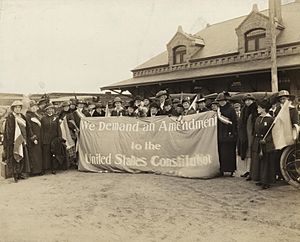
The Suffrage Special arrived in Tucson, Arizona on April 20. In Tucson, the suffragists toured the city. They spoke at a lunch and then at a dinner. The train arrived in Phoenix, Arizona on April 21. Dr. Marian Walker Williams welcomed them at a lunch at the Adams Hotel. The train had also stopped briefly in Maricopa.
On April 22, the Suffrage Special envoys had a smaller welcome in Los Angeles. Clara Shortridge Foltz met them at the station with a few women. They took the group to the Alexandria Hotel for a reception. Women in Los Angeles were not very excited about the delegates' mission. They did not strongly support forming another political party. The train left Los Angeles on April 24. It made a short stop in Santa Barbara.
In San Francisco, the Suffrage Special arrived on April 26. They were welcomed by the mayor's secretary, Edward Rainey. Later, they met with Mayor James Rolph. The group held a large meeting, led by Gail Laughlin. The train arrived in Reno, Nevada on April 26 in the evening. On April 27, the Suffrage Special arrived in Carson City, Nevada. There, they met Governor Emmet D. Boyle. Like women in Los Angeles, women in Nevada were not very supportive of forming a new women's party. The train stopped in Sacramento on the morning of April 28. The delegates attended a lunch with 1,500 guests.
The Suffrage Special arrived in Salem, Oregon on April 29. In Oregon, both men and women had passed a resolution. It criticized Congress for not passing a national women's suffrage law. The delegates left with several cases of loganberry juice. They continued on the morning of April 30 to Portland, Oregon.
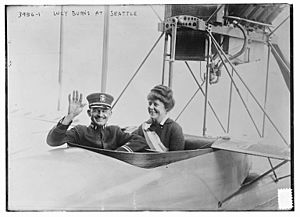
The Suffrage Special arrived in Seattle on May 1. They spent two days with various events in the city. The delegates were met at the train station. They took a trip around the city and gave speeches. The first day ended with a large meeting. This meeting took place at the Moore Theatre and had 1,500 people. The next day, the women were guests of the Women's Civic Club. There were more meetings. In Seattle, Lucy Burns took an airplane ride. She dropped leaflets over the city from the air.
On May 4, the train stopped in Spokane in the evening. There was a reception at the Davenport Hotel. In Spokane, the group adopted a black, stray dog. They named him "Spokie." Another event in Spokane was planting a tree. It was planted in memory of the suffragist May Arkwright Hutton.
The train spent a few hours in Great Falls, Montana on May 7. There was a large meeting in Helena, Montana. While Elizabeth Selden Rogers was speaking, the lights went out. But Rogers kept giving her speech. They arrived that afternoon in Butte. In Butte, they visited the city's mines. Then they had dinner at the Thornton Hotel. Afterward, they drove through the business area. They went to the city's auditorium for speeches. They encouraged women to support a national suffrage law.
In Butte, Spokie, the dog, was taken into a saloon. The men thought the women would not dare to go there. Abby Scott Baker got the dog back. She also got the bartender to drink to the "health of suffrage." The next day, the delegates visited another mine. They held another lunch with speakers at the Thornton Hotel.
They traveled from Pocatello to Boise. They arrived there on May 9. The women arrived in Boise in the evening. They were taken to Pinney Theater for a large meeting. On May 10, the women met with state officials. Governor Moses Alexander promised that Idaho would approve a national suffrage law. The train left at noon for another large meeting in Pocatello.
Ida Smoot helped welcome the Suffrage Special to Salt Lake City on May 11. The group arrived in the morning. They were taken to Hotel Utah. After breakfast, they were guests of the First Presidency. They enjoyed an organ concert at the Tabernacle. Then, mounted police escorted them in a street parade. Meetings continued through the day. The next day, a business meeting was held at Hotel Utah. Farewell events followed in the afternoon at Pioneer Park.
On May 14, the train stopped for three hours in St. Joseph, Missouri. They had dinner and a meeting at the Scottish Rite Cathedral.
The Suffrage Special returned to Washington, D.C., on May 16. A "White Luncheon" took place at Union Station. About 300 women attended the lunch. A parade was held as the delegates took their petitions to the United States Congress. Three hundred schoolgirls dressed in white. They formed lines up the steps of the Capitol. The delegates marched in with their petitions. Five girls walked in front of them, "strewing flowers in their path." At the top of the steps, Belva Ann Lockwood held a Congressional Union banner. As they marched, "The Women's Marseillaise" was played. The Senate stopped its work to receive the delegates. Lawmakers were surrounded by a rope held by 100 women. Around them, a circle of yellow ribbon was held by the girls. The women then spoke to Congress. They asked them to support women's right to vote. The women had also brought a 150-pound iced cake as a gift for President Wilson.
What Happened Next
In June 1916, the women involved with the Suffrage Special held a convention in Chicago. There, they officially created the National Woman's Party (NWP).
Delegates on the Trip
The women who went on the trip represented several states. Anne Henrietta Martin from Nevada joined the group for part of the journey. Other women who had been chosen at a meeting in Salt Lake City also joined the original travelers. Spokie, the adopted stray dog, went with Helen Todd to New York after the trip.
Original Delegates
- Lillian Ascough, Connecticut
- Abby Scott Baker, Washington, D.C.
- Alva Belmont, New York
- Harriet Stanton Blatch, New York
- Lucy Burns, New York
- Mrs. A. R. Colvin, Minnesota
- Agnes Campbell, New Jersey
- Anna Constable, New York
- Edith J. Goode, Ohio
- Jane Goode, Ohio
- Florence Bayard Hilles, Delaware
- Julia Hurlbut, New Jersey
- Caroline Katzenstein, Pennsylvania
- Winifred Mallon, Washington, D.C.
- Dorothy Mead, Ohio
- Inez Milholland, New York
- Agnes Morey, Massachusetts
- Katherine Morey, Massachusetts
- Gertrude B. Newell, Massachusetts
- Marion T. Read, Virginia
- Ella Riegel, Pennsylvania
- Elizabeth Selden Rogers, New York
- Melinda Scott, New York
- Mrs. Townsend Scott, Maryland
- Helen Todd, New York
Delegates from Convention
- Mrs. John B. Allen, Washington
- Mrs. Frederick C. Alsdorf, Arizona
- Frances Axtell, Washington
- Mrs. Dan Casement, Kansas
- Elizabeth Gerberding, California
- Mrs. Oscar Groshell, Utah
- Frances Haire, Montana
- Phoebe Hearst, California
- Alice Reynolds, Utah
- Mrs. Wallace Williams, Washington


